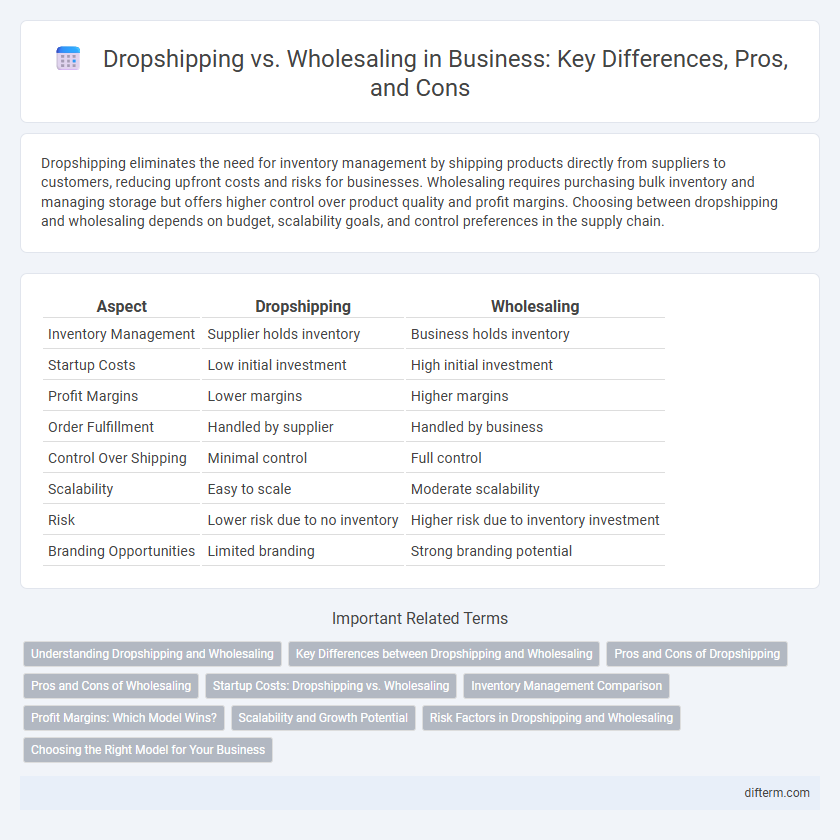Dropshipping eliminates the need for inventory management by shipping products directly from suppliers to customers, reducing upfront costs and risks for businesses. Wholesaling requires purchasing bulk inventory and managing storage but offers higher control over product quality and profit margins. Choosing between dropshipping and wholesaling depends on budget, scalability goals, and control preferences in the supply chain.
Table of Comparison
| Aspect | Dropshipping | Wholesaling |
|---|---|---|
| Inventory Management | Supplier holds inventory | Business holds inventory |
| Startup Costs | Low initial investment | High initial investment |
| Profit Margins | Lower margins | Higher margins |
| Order Fulfillment | Handled by supplier | Handled by business |
| Control Over Shipping | Minimal control | Full control |
| Scalability | Easy to scale | Moderate scalability |
| Risk | Lower risk due to no inventory | Higher risk due to inventory investment |
| Branding Opportunities | Limited branding | Strong branding potential |
Understanding Dropshipping and Wholesaling
Dropshipping involves selling products directly from a supplier to the customer without holding inventory, reducing upfront costs and minimizing risk. Wholesaling requires purchasing large quantities of products to store and sell, allowing for higher profit margins but demanding significant capital investment. Understanding the operational differences and financial implications of dropshipping and wholesaling is crucial for selecting the right business model.
Key Differences between Dropshipping and Wholesaling
Dropshipping involves selling products without holding inventory, where suppliers ship directly to customers, whereas wholesaling requires purchasing bulk inventory for resale. Dropshipping minimizes upfront investment and inventory risk, while wholesaling demands significant capital but offers higher profit margins. The speed of order fulfillment is generally faster in wholesaling due to direct control over stock, contrasting with the dependency on suppliers in dropshipping.
Pros and Cons of Dropshipping
Dropshipping offers low startup costs and minimal inventory risk by allowing businesses to sell products without holding stock, enabling easy scalability and a wide product range. However, it presents challenges such as lower profit margins, less control over shipping times and product quality, and dependence on suppliers for inventory availability. Entrepreneurs must weigh the convenience and flexibility against these limitations when choosing dropshipping as a business model.
Pros and Cons of Wholesaling
Wholesaling offers the advantage of purchasing products in bulk at lower costs, enabling higher profit margins and greater control over inventory management compared to dropshipping. However, it requires significant upfront investment and storage space, increasing financial risk and operational complexity. Businesses must weigh the benefits of scalability and direct supplier relationships against the challenges of inventory holding and potential unsold stock.
Startup Costs: Dropshipping vs. Wholesaling
Dropshipping requires significantly lower startup costs as it eliminates the need for inventory purchase and warehouse expenses, making it ideal for entrepreneurs with limited capital. Wholesaling demands substantial upfront investment in bulk inventory, storage facilities, and logistics management, which can increase financial risk. Choosing dropshipping reduces initial financial barriers, whereas wholesaling offers higher profit margins but involves greater startup capital and operational overhead.
Inventory Management Comparison
Dropshipping eliminates the need for inventory storage by directly shipping products from suppliers to customers, reducing overhead but limiting control over stock availability and shipping times. Wholesaling requires maintaining an inventory, allowing for better quality control and faster order fulfillment but increasing storage costs and risk of unsold goods. Efficient inventory management in wholesaling depends on accurate demand forecasting and warehouse optimization, while dropshipping prioritizes supplier reliability and integration with real-time inventory tracking systems.
Profit Margins: Which Model Wins?
Dropshipping typically offers lower profit margins, ranging from 10% to 30%, due to higher product costs and supplier fees, while wholesaling often achieves margins between 30% and 50% by purchasing inventory in bulk at discounted rates. Wholesaling demands upfront investment and inventory management but allows greater control over pricing strategies and stronger margin potential. Strategic businesses lean towards wholesaling for maximizing profits despite increased operational demands.
Scalability and Growth Potential
Dropshipping offers high scalability due to low upfront inventory costs and the ability to quickly add diverse products without significant financial risk, facilitating rapid business expansion. Wholesaling demands larger capital investment in bulk inventory, which can limit agility but provides better profit margins and control over stock, supporting steady, sustainable growth. Entrepreneurs seeking fast market entry and flexible scaling often prefer dropshipping, while those aiming for consistent volume sales and higher long-term profitability might choose wholesaling.
Risk Factors in Dropshipping and Wholesaling
Dropshipping presents higher risks related to supplier reliability and inventory control, as businesses depend entirely on third-party vendors for product availability and shipment. Wholesaling involves inventory investment, leading to financial risk if products do not sell, but provides greater control over stock quality and fulfillment timing. Understanding these risk factors is essential for businesses to choose the right model aligned with their operational capabilities and market strategy.
Choosing the Right Model for Your Business
Choosing between dropshipping and wholesaling depends on your business goals, budget, and inventory management preferences. Dropshipping requires less upfront investment and eliminates the need for inventory storage, allowing you to focus on marketing and customer service. Wholesaling offers higher profit margins and greater control over product quality but demands significant capital and efficient logistics.
dropshipping vs wholesaling Infographic

 difterm.com
difterm.com